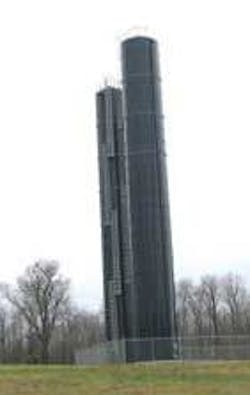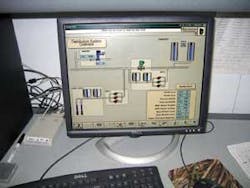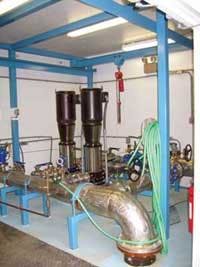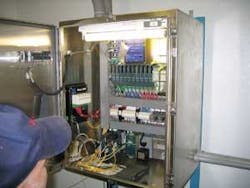SCADA System Helps Utility Create Public Water Supply for Mountain Communities
By Todd Radolec
For the first time ever, 12,000 people in the hills of Western Pennsylvania have access to public drinking water, thanks to an automated water supply system that pumps water uphill from deep wells. The firm of McMillen Engineering designed and implemented the innovative SCADA system within tight budget constraints, using a low-cost Foxboro A2 automation system, connected by 20 miles of fiber optic cable.
Controlling the system presented some significant challenges. It was a grounds-up job complicated by geography. Multiple control strategies were needed to synchronize the complex system involving the two mountain wells, two pumping stations and two large storage facilities that were needed to maintain quality water delivery through the hilly region. The strategies included the following automated processes:
• Precise orchestration of control valves to ensure pump directional flow
• Flow regulation at pump stations to maintain precise standpipe levels
• Tank pressure and resultant altitude control valve positioning
• Routine but critical replenishment calls between pump stations
• Chlorination and back-up pumping
• Auto to Manual pump power switching
• Collection of flow data to monitor contracted usage at a large local resort
• Generation of real-time data used for billing and reporting
These strategies combined to reduce costs to the municipalities and end users and to ensure high quality service. Automating chlorination and collection of real-time usage data had very specific financial benefits while other aspects of the automation contributed quality of service and improved productivity, reducing the need for manpower to make routine site visits.
Background
Residents of Pennsylvania Laurel Mountains began to feel the need for a public water supply after several years of increasing drought conditions. They had been relying on private wells, but decreasing rainfall in the higher elevations combined with increasing commercial development threatened both the supply and the quality of the private well water. Some residents had, in fact, already turned exclusively to bottled water for drinking.
Two communities in the region, the Henry Clay Township and Markleysburg Borough, formed the National Pike Water Authority to address regional water supply issues and obtain funding. They were successful in raising more than $7 million in grant funding and were eventually joined by three other communities, the Stewart and Wharton Townships and Fayette County. The authority engaged the civil engineering firm of McMillen Engineering to develop a reliable public water source for the region.
After extensive analysis of the options, the firm concluded that drilling two deep wells in the mountains of the Henry Clay Township could meet the region’s needs with water so pure that only minimal treatment would be required. Distributing that water economically amidst the Laurel Mountains presented many challenges, however.
McMillen Engineering met these challenges with a system of wells, pump stations, storage facilities and control valves that spanned across twenty miles of pipeline, all synchronized by the Foxboro A2-driven SCADA system, communicating across fiber optic cables.
Uphill battle
Contributing significantly to the challenge was the fact that the water source would actually be below the point of storage and distribution, which meant water would have to be pumped uphill. This is much different from the preferred situation, which seeks to identify water sources and storage at higher elevations so that it can flow more easily and economically to standpipes for storage.
Achieving this with minimal piping meant that the same channels that fed the standpipes would also distribute the water to the users. This bi-directional flow required precise orchestration of control valve openings and closings to assure that pumps carrying water in opposite directions were not pumping against each other.
Two 14 foot diameter standpipes, towering 112 feet about the ground on Pennsylvania’s Route 40 are the main storage facilities for the region’s water supply. SCADA controls at a pump station in near proximity to the standpipes regulate the flow of water that arrives from the wells and the redistribution of that water to users. This maintains standpipe elevation always within a 36 foot range, between 2632 and 2596 feet above sea level. If the level exceeds that range the tank will overflow; if it falls below, there will not be enough pressure to operate the system efficiently.
To maintain this level, the SCADA system reads tank pressure from pressure transmitters at each tank and controls the opening or closing of altitude control valves as needed. When the water level reaches a specified setpoint, the SCADA controls call for replenishment from pump station two, located a half mile away. If the pumps and buffer storage tanks at pump station two are not able to satisfy fill requirements, the SCADA system is programmed to call and receive supply directly from pump station number one, which is located near the wells.
In addition to managing supply from the two pump stations, the SCADA panel at pump station number two coordinates high and low level alarms across the system, chlorination, and back up pumping that could be used during a power outage. The system also accommodates manual controls, should there be a failure of the digital system.
When pressure transmitters indicate that adequate levels are reached, the SCADA controls re-open recirculation valves enabling flow to users. Pump station number two provides water to the pressure zones one and two, which includes the Henry Clay Township and Markleysburg Borough. A pilot operated valve at the station header allows flow to be bidirectional through that station, depending on the residual pressure and availability of power. Two pre-cast concrete ground storage tanks provide a system buffer and gravity suction supply. Combination altitude and flow control valves balance filling of this tank with supply and demand conditions of the other two pump stations.
When either of the standpipes calls for more water, for example, the SCADA system will close the pilot operated valve at pump station two and then check to see if there is enough suction pressure in the local buffer tank. If there is, it will pump until the SCADA system detects adequate levels or until it is mechanically controlled.
Another SCADA control station manages flow to the Nemacolin Woodlands Resort, which, with rights to demand up to 175,000 gallons of water per day, is the system’s largest single user, as well as a contributor of funding for the development of the system. A venturi-based rate of flow controller there transmits flow data to the SCADA systems, providing both billing and demand control data in real time.
The SCADA system controls the rate of flow controllers’ electrically actuated butterfly valve to modulate flow between the minimum amount for which the resort had contracted, and the maximum of 175,000 gpd. This enables usage monitoring, reporting and billing as well as demand control.
Right-sizing the SCADA controls
Although the system is small by standards of larger metropolitan areas, managing the bi-directional flow based on information from multiple points required a centralized, carefully executed, highly reliable solution. Operations with such requirements are often best served by large, fully featured distributed control systems (DCS) but because of the relatively small size of the communities available resources were limited.
On the other extreme, where budget is an issue, lower cost “programmable logic controllers” (PLCs) are deployed. PLC-based SCADA systems can be lower in equipment cost but may require more upfront configuration, much of which is localized, and are costlier to maintain. McMillen considered one bid using new PLC technology that would have been more amenable to centralized control, but this was also more expensive than conventional PLCs and unproven in water engineering.
Familiar with the Foxboro reputation as a supplier of premium technology to utilities markets, McMillen engineers requested a bid for a control system based on the Foxboro A2 automation system, a mini-DCS which had already been proven in remote SCADA water industry applications. With this system, they were able to get full DCS functionality for less than it would have cost using the proposed PLC solution. The Foxboro solution was also more open and more expandable than the alternative.
The cable connection
Where most water installations of this sort require extensive treatment engineering, the mountainous terrain made communications a much greater challenge. SCADA signals are only as good as the path on which they travel.
A radio study showed that there was no way to provide direct communications between the communications and the I/O systems so a wireless system would require construction of two repeater towers. In addition to the expense of constructing the towers, however, it would be necessary to obtain clearances to build them on private property or on land with historical significance. A more economical solution was to install conduit alongside the waterline and collaborate with the local cable television provider to run fiber optic cable through the conduit. This saved the approximately half-million dollars that would have otherwise been required to construct the towers and also provided a steadier, more reliable signal.
The cables connect to the control system I/O through a black box fiber optic converter, which accepts the I/O signals from the control system and converts them to the light transmissions which signal operations of the pumps and actuators.
In operation
The system has been on line since April 2004, pumping 200,000 gpd, with capacity to pump up to 700,000 gpd. For the first time ever, the people in communities served by the NPWA have access to public drinking water. Each pays $1000 to tie into the system, plus $30 a month. 98 percent of the eligible users have tied into the system.
Although operators interact with the system on a daily basis, most of the operation is automated by the controls, driven primarily by the levels of the standpipes. Operators view onscreen representations of well supply and tank levels. They can tell whether a pump is on, off or on standby, designated by green, red or yellow coloring. They can also get numerical indices of level and press and generate a wide variety of charts and tables depicting historical and trend data.
The system has already eliminated between 2 and 4 hours of maintenance time per day, time that otherwise would have been spent visiting tanks, measuring levels, adjusting controls and recording information.
And the system can be expanded easily as the demand for water in the region increases as more residents tie in to the system, and the availability of public water attracts more commercial development to the region.
Conclusion
When complicated control strategies are required, a flexible, DCS-managed SCADA system can provide centralized control of flow to multiple end users while reducing engineering, operating and maintenance costs. This assures the highest quality of service, at the lowest cost with minimum ongoing usage fees.
About the Author:
Todd Radolec is a project engineer for McMillen Engineering, a full-service civil engineering firm in Uniontown, PA. He provides management and engineering on structural design, traffic engineering, water and wastewater engineering, hydraulic engineering, and commercial land development projects. He holds a Bachelor’s of Science degree in Civil Engineering from Pennsylvania State University and is state representative for the Fayette Chapter of the Pennsylvania Society of Professional Engineers. He can be reached via e-mail at [email protected].




